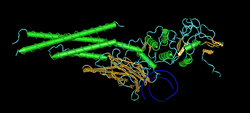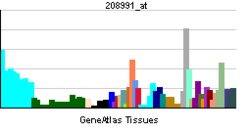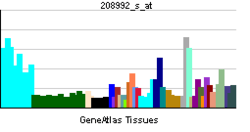STAT3
| View/Edit Human | View/Edit Mouse |
Signal transducer and activator of transcription 3 (STAT3) is a transcription factor which in humans is encoded by the STAT3 gene.[4] It is a member of the STAT protein family.
Function
STAT3 is a member of the STAT protein family. In response to cytokines and growth factors, STAT3 is phosphorylated by receptor-associated Janus kinases (JAK), form homo- or heterodimers, and translocate to the cell nucleus where they act as transcription activators. Specifically, STAT3 becomes activated after phosphorylation of tyrosine 705 in response to such ligands as interferons, epidermal growth factor (EGF), Interleukin (IL-)5 and IL-6. Additionally, activation of STAT3 may occur via phosphorylation of serine 727 by Mitogen-activated protein kinases (MAPK)[5] and through c-src non-receptor tyrosine kinase.[6][7] STAT3 mediates the expression of a variety of genes in response to cell stimuli, and thus plays a key role in many cellular processes such as cell growth and apoptosis.[8]
STAT3-deficient mouse embryos cannot develop beyond embryonic day 7, when gastrulation begins.[9] It appears that at these early stages of development, STAT3 activation is required for self-renewal of embryonic stem cells (ESCs). Indeed, LIF, which is supplied to murine ESC cultures to maintain their undifferentiated state, can be omitted if STAT3 is activated through some other means.[10]
STAT3 is essential for the differentiation of the TH17 helper T cells, which have been implicated in a variety of autoimmune diseases.[11]
Clinical significance
Loss-of-function mutations in the STAT3 gene result in Hyperimmunoglobulin E syndrome, associated with recurrent infections as well as disordered bone and tooth development.[12]
Gain-of-function mutations in the STAT3 gene have been reported to cause multi-organ early onset auto-immune diseases; such as thyroid disease, diabetes, intestinal inflammation, and low blood counts,[13] while constitutive STAT3 activation is associated with various human cancers and commonly suggests poor prognosis.[14][15][16][17] It has anti-apoptotic as well as proliferative effects.[14] STAT3 can promote oncogenesis by being constitutively active through various pathways as mentioned elsewhere. Very recently a tumor suppressor role of STAT3 has also been reported.[18][19][20] In the report on human glioblastoma tumor, or brain cancer, STAT3 was shown to have an oncogenic or a tumor suppressor role depending upon the mutational background of the tumor. A direct connection between the PTEN-Akt-FOXO axis (suppressive) and the leukemia inhibitory factor receptor beta (LIFRbeta)-STAT3 signaling pathway (oncogenic) was shown. In addition, two recent studies performed in APC mutant mice showed that STAT3 has an inhibiting role in colon carcinogenesis depending on tumor stage.
Interactions
STAT3 has been shown to interact with:
References
- ↑ "Diseases that are genetically associated with STAT3 view/edit references on wikidata".
- ↑ "Human PubMed Reference:".
- ↑ "Mouse PubMed Reference:".
- ↑ Akira S, Nishio Y, Inoue M, Wang XJ, Wei S, Matsusaka T, Yoshida K, Sudo T, Naruto M, Kishimoto T (Apr 1994). "Molecular cloning of APRF, a novel IFN-stimulated gene factor 3 p91-related transcription factor involved in the gp130-mediated signaling pathway". Cell. 77 (1): 63–71. doi:10.1016/0092-8674(94)90235-6. PMID 7512451.
- ↑ Tkach M, Rosemblit C, Rivas MA, Proietti CJ, Díaz Flaqué MC, Mercogliano MF, Beguelin W, Maronna E, Guzmán P, Gercovich FG, Deza EG, Elizalde PV, Schillaci R (March 2013). "p42/p44 MAPK-mediated Stat3Ser727 phosphorylation is required for progestin-induced full activation of Stat3 and breast cancer growth". Endocrine-related cancer. 20 (2): 197–212. doi:10.1530/ERC-12-0194. PMID 23329648.
- ↑ Silva CM (Oct 2004). "Role of STATs as downstream signal transducers in Src family kinase-mediated tumorigenesis". Oncogene. 23 (48): 8017–8023. doi:10.1038/sj.onc.1208159. PMID 15489919.
- ↑ Lim CP, Cao X (Nov 2006). "Structure, function, and regulation of STAT proteins". Molecular BioSystems. 2 (11): 536–550. doi:10.1039/B606246F. PMID 17216035..
- ↑ Yuan ZL, Guan YJ, Wang L, Wei W, Kane AB, Chin YE (Nov 2004). "Central role of the threonine residue within the p+1 loop of receptor tyrosine kinase in STAT3 constitutive phosphorylation in metastatic cancer cells". Molecular and Cellular Biology. 24 (21): 9390–9400. doi:10.1128/MCB.24.21.9390-9400.2004. PMC 522220
 . PMID 15485908. 15485908.
. PMID 15485908. 15485908. - ↑ Takeda K, Noguchi K, Shi W, Tanaka T, Matsumoto M, Yoshida N, Kishimoto T, Akira S (Apr 1997). "Targeted disruption of the mouse Stat3 gene leads to early embryonic lethality". Proceedings of the National Academy of Sciences of the United States of America. 94 (8): 3801–3804. doi:10.1073/pnas.94.8.3801. PMC 20521
 . PMID 9108058.
. PMID 9108058. - ↑ Matsuda T, Nakamura T, Nakao K, Arai T, Katsuki M, Heike T, Yokota T (Aug 1999). "STAT3 activation is sufficient to maintain an undifferentiated state of mouse embryonic stem cells". The EMBO Journal. 18 (15): 4261–4269. doi:10.1093/emboj/18.15.4261. PMC 1171502
 . PMID 10428964.
. PMID 10428964. - ↑ Yang XO, Panopoulos AD, Nurieva R, Chang SH, Wang D, Watowich SS, Dong C (Mar 2007). "STAT3 regulates cytokine-mediated generation of inflammatory helper T cells". The Journal of Biological Chemistry. 282 (13): 9358–9363. doi:10.1074/jbc.C600321200. PMID 17277312.
- ↑ Levy DE, Loomis CA (Oct 2007). "STAT3 signaling and the hyper-IgE syndrome". The New England Journal of Medicine. 357 (16): 1655–1658. doi:10.1056/NEJMe078197. PMID 17881746.
- ↑ Milner JD, Vogel TP, Forbes L, Ma CA, Stray-Pedersen A, Niemela JE, et al. (Jan 2015). "Early-onset lymphoproliferation and autoimmunity caused by germline STAT3 gain-of-function mutations". Blood. 125 (4): 591–9. doi:10.1182/blood-2014-09-602763. PMC 4304103
 . PMID 25359994.
. PMID 25359994. - 1 2 Klampfer L (Mar 2006). "Signal transducers and activators of transcription (STATs): Novel targets of chemopreventive and chemotherapeutic drugs". Current Cancer Drug Targets. 6 (2): 107–121. doi:10.2174/156800906776056491. PMID 16529541.
- ↑ Alvarez JV, Greulich H, Sellers WR, Meyerson M, Frank DA (Mar 2006). "Signal transducer and activator of transcription 3 is required for the oncogenic effects of non-small-cell lung cancer-associated mutations of the epidermal growth factor receptor". Cancer Research. 66 (6): 3162–3168. doi:10.1158/0008-5472.CAN-05-3757. PMID 16540667.
- ↑ Yin W, Cheepala S, Roberts JN, Syson-Chan K, DiGiovanni J, Clifford JL (2006). "Active Stat3 is required for survival of human squamous cell carcinoma cells in serum-free conditions". Molecular Cancer. 5 (1): 15. doi:10.1186/1476-4598-5-15. PMC 1502137
 . PMID 16603078.
. PMID 16603078. - ↑ Kusaba T, Nakayama T, Yamazumi K, Yakata Y, Yoshizaki A, Inoue K, Nagayasu T, Sekine I (Jun 2006). "Activation of STAT3 is a marker of poor prognosis in human colorectal cancer". Oncology Reports. 15 (6): 1445–51. doi:10.3892/or.15.6.1445. PMID 16685378.
- ↑ de la Iglesia N, Konopka G, Puram SV, Chan JA, Bachoo RM, You MJ, Levy DE, Depinho RA, Bonni A (Feb 2008). "Identification of a PTEN-regulated STAT3 brain tumor suppressor pathway". Genes & Development. 22 (4): 449–462. doi:10.1101/gad.1606508. PMC 2238667
 . PMID 18258752.
. PMID 18258752. - ↑ Lee J, Kim JC, Lee SE, Quinley C, Kim H, Herdman S, Corr M, Raz E (May 2012). "Signal transducer and activator of transcription 3 (STAT3) protein suppresses adenoma-to-carcinoma transition in Apcmin/+ mice via regulation of Snail-1 (SNAI) protein stability". The Journal of Biological Chemistry. 22. 287 (22): 18182–18189. doi:10.1074/jbc.M111.328831. PMID 22496368.
- ↑ Musteanu M, Blaas L, Mair M, Schlederer M, Bilban M, Tauber S, Esterbauer H, Mueller M, Casanova E, Kenner L, Poli V, Eferl R (Mar 2010). "Stat3 is a negative regulator of intestinal tumor progression in Apc(Min) mice". Gastroenterology. 138 (3): 1003–1011. doi:10.1053/j.gastro.2009.11.049. PMID 19962983.
- 1 2 Ueda T, Bruchovsky N, Sadar MD (Mar 2002). "Activation of the androgen receptor N-terminal domain by interleukin-6 via MAPK and STAT3 signal transduction pathways". The Journal of Biological Chemistry. 277 (9): 7076–85. doi:10.1074/jbc.M108255200. PMID 11751884.
- ↑ Matsuda T, Junicho A, Yamamoto T, Kishi H, Korkmaz K, Saatcioglu F, Fuse H, Muraguchi A (Apr 2001). "Cross-talk between signal transducer and activator of transcription 3 and androgen receptor signaling in prostate carcinoma cells". Biochemical and Biophysical Research Communications. 283 (1): 179–87. doi:10.1006/bbrc.2001.4758. PMID 11322786.
- ↑ Collum RG, Brutsaert S, Lee G, Schindler C (Aug 2000). "A Stat3-interacting protein (StIP1) regulates cytokine signal transduction". Proceedings of the National Academy of Sciences of the United States of America. 97 (18): 10120–5. doi:10.1073/pnas.170192197. PMC 27739
 . PMID 10954736.
. PMID 10954736. - ↑ Nakashima K, Yanagisawa M, Arakawa H, Kimura N, Hisatsune T, Kawabata M, Miyazono K, Taga T (Apr 1999). "Synergistic signaling in fetal brain by STAT3-Smad1 complex bridged by p300". Science. 284 (5413): 479–82. doi:10.1126/science.284.5413.479. PMID 10205054.
- 1 2 Yuan ZL, Guan YJ, Wang L, Wei W, Kane AB, Chin YE (Nov 2004). "Central role of the threonine residue within the p+1 loop of receptor tyrosine kinase in STAT3 constitutive phosphorylation in metastatic cancer cells". Molecular and Cellular Biology. 24 (21): 9390–400. doi:10.1128/MCB.24.21.9390-9400.2004. PMC 522220
 . PMID 15485908.
. PMID 15485908. - ↑ Olayioye MA, Beuvink I, Horsch K, Daly JM, Hynes NE (Jun 1999). "ErbB receptor-induced activation of stat transcription factors is mediated by Src tyrosine kinases". The Journal of Biological Chemistry. 274 (24): 17209–18. doi:10.1074/jbc.274.24.17209. PMID 10358079.
- ↑ Jung JE, Kim HS, Lee CS, Shin YJ, Kim YN, Kang GH, Kim TY, Juhnn YS, Kim SJ, Park JW, Ye SK, Chung MH (Oct 2008). "STAT3 inhibits the degradation of HIF-1alpha by pVHL-mediated ubiquitination". Experimental & Molecular Medicine. 40 (5): 479–85. doi:10.3858/emm.2008.40.5.479. PMC 2679355
 . PMID 18985005.
. PMID 18985005. - 1 2 Spiekermann K, Biethahn S, Wilde S, Hiddemann W, Alves F (Aug 2001). "Constitutive activation of STAT transcription factors in acute myelogenous leukemia". European Journal of Haematology. 67 (2): 63–71. doi:10.1034/j.1600-0609.2001.t01-1-00385.x. PMID 11722592.
- ↑ Zhang X, Wrzeszczynska MH, Horvath CM, Darnell JE (Oct 1999). "Interacting regions in Stat3 and c-Jun that participate in cooperative transcriptional activation". Molecular and Cellular Biology. 19 (10): 7138–46. PMC 84707
 . PMID 10490649.
. PMID 10490649. - ↑ Sanchez-Margalet V, Martin-Romero C (Jul 2001). "Human leptin signaling in human peripheral blood mononuclear cells: activation of the JAK-STAT pathway". Cellular Immunology. 211 (1): 30–6. doi:10.1006/cimm.2001.1815. PMID 11585385.
- ↑ Yokogami K, Wakisaka S, Avruch J, Reeves SA (Jan 2000). "Serine phosphorylation and maximal activation of STAT3 during CNTF signaling is mediated by the rapamycin target mTOR". Current Biology. 10 (1): 47–50. doi:10.1016/S0960-9822(99)00268-7. PMID 10660304.
- ↑ Kusaba H, Ghosh P, Derin R, Buchholz M, Sasaki C, Madara K, Longo DL (Jan 2005). "Interleukin-12-induced interferon-gamma production by human peripheral blood T cells is regulated by mammalian target of rapamycin (mTOR)". The Journal of Biological Chemistry. 280 (2): 1037–43. doi:10.1074/jbc.M405204200. PMID 15522880.
- ↑ Kataoka Y, Matsumura I, Ezoe S, Nakata S, Takigawa E, Sato Y, Kawasaki A, Yokota T, Nakajima K, Felsani A, Kanakura Y (Nov 2003). "Reciprocal inhibition between MyoD and STAT3 in the regulation of growth and differentiation of myoblasts". The Journal of Biological Chemistry. 278 (45): 44178–87. doi:10.1074/jbc.M304884200. PMID 12947115.
- ↑ Zhang J, Yang J, Roy SK, Tininini S, Hu J, Bromberg JF, Poli V, Stark GR, Kalvakolanu DV (Aug 2003). "The cell death regulator GRIM-19 is an inhibitor of signal transducer and activator of transcription 3". Proceedings of the National Academy of Sciences of the United States of America. 100 (16): 9342–7. doi:10.1073/pnas.1633516100. PMC 170920
 . PMID 12867595.
. PMID 12867595. - 1 2 Yu Z, Zhang W, Kone BC (Oct 2002). "Signal transducers and activators of transcription 3 (STAT3) inhibits transcription of the inducible nitric oxide synthase gene by interacting with nuclear factor kappaB". The Biochemical Journal. 367 (Pt 1): 97–105. doi:10.1042/BJ20020588. PMC 1222853
 . PMID 12057007.
. PMID 12057007. - ↑ Lerner L, Henriksen MA, Zhang X, Darnell JE (Oct 2003). "STAT3-dependent enhanceosome assembly and disassembly: synergy with GR for full transcriptional increase of the alpha 2-macroglobulin gene". Genes & Development. 17 (20): 2564–77. doi:10.1101/gad.1135003. PMC 218150
 . PMID 14522952.
. PMID 14522952. - ↑ Zhang Z, Jones S, Hagood JS, Fuentes NL, Fuller GM (Dec 1997). "STAT3 acts as a co-activator of glucocorticoid receptor signaling". The Journal of Biological Chemistry. 272 (49): 30607–10. doi:10.1074/jbc.272.49.30607. PMID 9388192.
- ↑ Giraud S, Bienvenu F, Avril S, Gascan H, Heery DM, Coqueret O (Mar 2002). "Functional interaction of STAT3 transcription factor with the coactivator NcoA/SRC1a". The Journal of Biological Chemistry. 277 (10): 8004–11. doi:10.1074/jbc.M111486200. PMID 11773079.
- ↑ Kawasaki A, Matsumura I, Kataoka Y, Takigawa E, Nakajima K, Kanakura Y (May 2003). "Opposing effects of PML and PML/RAR alpha on STAT3 activity". Blood. 101 (9): 3668–73. doi:10.1182/blood-2002-08-2474. PMID 12506013.
- ↑ Simon AR, Vikis HG, Stewart S, Fanburg BL, Cochran BH, Guan KL (Oct 2000). "Regulation of STAT3 by direct binding to the Rac1 GTPase". Science. 290 (5489): 144–7. doi:10.1126/science.290.5489.144. PMID 11021801.
- ↑ Hwang JH, Kim DW, Suh JM, Kim H, Song JH, Hwang ES, Park KC, Chung HK, Kim JM, Lee TH, Yu DY, Shong M (Jun 2003). "Activation of signal transducer and activator of transcription 3 by oncogenic RET/PTC (rearranged in transformation/papillary thyroid carcinoma) tyrosine kinase: roles in specific gene regulation and cellular transformation". Molecular Endocrinology. 17 (6): 1155–66. doi:10.1210/me.2002-0401. PMID 12637586.
- ↑ Schuringa JJ, Wojtachnio K, Hagens W, Vellenga E, Buys CH, Hofstra R, Kruijer W (Aug 2001). "MEN2A-RET-induced cellular transformation by activation of STAT3". Oncogene. 20 (38): 5350–8. doi:10.1038/sj.onc.1204715. PMID 11536047.
- ↑ Kim J, Kim D, Chung J (2000). "Replication protein a 32 kDa subunit (RPA p32) binds the SH2 domain of STAT3 and regulates its transcriptional activity". Cell Biology International. 24 (7): 467–73. doi:10.1006/cbir.2000.0525. PMID 10875894.
- ↑ Gunaje JJ, Bhat GJ (Oct 2001). "Involvement of tyrosine phosphatase PTP1D in the inhibition of interleukin-6-induced Stat3 signaling by alpha-thrombin". Biochemical and Biophysical Research Communications. 288 (1): 252–7. doi:10.1006/bbrc.2001.5759. PMID 11594781.
- ↑ Xia L, Wang L, Chung AS, Ivanov SS, Ling MY, Dragoi AM, Platt A, Gilmer TM, Fu XY, Chin YE (Aug 2002). "Identification of both positive and negative domains within the epidermal growth factor receptor COOH-terminal region for signal transducer and activator of transcription (STAT) activation". The Journal of Biological Chemistry. 277 (34): 30716–23. doi:10.1074/jbc.M202823200. PMID 12070153.
- ↑ Cao X, Tay A, Guy GR, Tan YH (Apr 1996). "Activation and association of Stat3 with Src in v-Src-transformed cell lines". Molecular and Cellular Biology. 16 (4): 1595–603. PMC 231145
 . PMID 8657134.
. PMID 8657134. - ↑ Chung YH, Cho NH, Garcia MI, Lee SH, Feng P, Jung JU (Jun 2004). "Activation of Stat3 transcription factor by Herpesvirus saimiri STP-A oncoprotein". Journal of Virology. 78 (12): 6489–97. doi:10.1128/JVI.78.12.6489-6497.2004. PMC 416526
 . PMID 15163742.
. PMID 15163742. - ↑ Liu L, McBride KM, Reich NC (Jun 2005). "STAT3 nuclear import is independent of tyrosine phosphorylation and mediated by importin-alpha3". Proc Natl Acad Sci U S A. 102 (23): 8150–5. doi:10.1073/pnas.0501643102. PMC 1149424
 . PMID 15919823.
. PMID 15919823.
Further reading
- Hoey T, Grusby MJ (1999). "STATs as mediators of cytokine-induced responses". Advances in Immunology. Advances in Immunology. 71: 145–162. doi:10.1016/S0065-2776(08)60401-0. ISBN 978-0-12-022471-5. PMID 9917912.
- Kisseleva T, Bhattacharya S, Braunstein J, Schindler CW (Feb 2002). "Signaling through the JAK/STAT pathway, recent advances and future challenges". Gene. 285 (1-2): 1–24. doi:10.1016/S0378-1119(02)00398-0. PMID 12039028.
- Joseph AM, Kumar M, Mitra D (Jan 2005). "Nef: "necessary and enforcing factor" in HIV infection". Current HIV Research. 3 (1): 87–94. doi:10.2174/1570162052773013. PMID 15638726.
- Inghirami G, Chiarle R, Simmons WJ, Piva R, Schlessinger K, Levy DE (Sep 2005). "New and old functions of STAT3: a pivotal target for individualized treatment of cancer". Cell Cycle. 4 (9): 1131–3. doi:10.4161/cc.4.9.1985. PMID 16082218.
- Leeman RJ, Lui VW, Grandis JR (Mar 2006). "STAT3 as a therapeutic target in head and neck cancer". Expert Opinion on Biological Therapy. 6 (3): 231–241. doi:10.1517/14712598.6.3.231. PMID 16503733.
- Aggarwal BB, Sethi G, Ahn KS, Sandur SK, Pandey MK, Kunnumakkara AB, Sung B, Ichikawa H (Dec 2006). "Targeting signal-transducer-and-activator-of-transcription-3 for prevention and therapy of cancer: modern target but ancient solution". Annals of the New York Academy of Sciences. 1091: 151–169. doi:10.1196/annals.1378.063. PMID 17341611.




